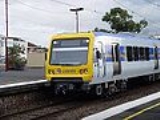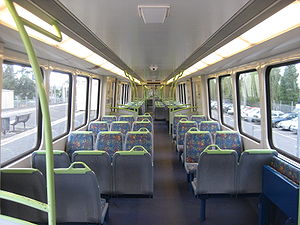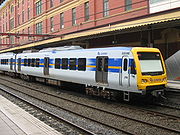
X'Trapolis 100
Encyclopedia

Train
A train is a connected series of vehicles for rail transport that move along a track to transport cargo or passengers from one place to another place. The track usually consists of two rails, but might also be a monorail or maglev guideway.Propulsion for the train is provided by a separate...
, one of Alstom
Alstom
Alstom is a large multinational conglomerate which holds interests in the power generation and transport markets. According to the company website, in the years 2010-2011 Alstom had annual sales of over €20.9 billion, and employed more than 85,000 people in 70 countries. Alstom's headquarters are...
's X'Trapolis
X'Trapolis
The X'Trapolis train is an electric passenger train, designed by the transport technology company Alstom. The trains have high floors, and are available in both single- and double-deck models.Models include:...
family of trains, used in Melbourne
Melbourne
Melbourne is the capital and most populous city in the state of Victoria, and the second most populous city in Australia. The Melbourne City Centre is the hub of the greater metropolitan area and the Census statistical division—of which "Melbourne" is the common name. As of June 2009, the greater...
, Australia and Valparaiso
Valparaíso
Valparaíso is a city and commune of Chile, center of its third largest conurbation and one of the country's most important seaports and an increasing cultural center in the Southwest Pacific hemisphere. The city is the capital of the Valparaíso Province and the Valparaíso Region...
, Chile.
First order
Melbourne Transport Enterprises (MTE), which was known as Connex MelbourneConnex Melbourne
Connex Melbourne was a wholly owned subsidiary of French company Veolia Environnement, which had a franchise from the State Government of Victoria to operate all suburban passenger rail services in Melbourne, Victoria, Australia. In August 2007, Connex's contract was extended to 30 November 2009....
(and since replaced by Metro Trains Melbourne
Metro Trains Melbourne
Metro Trains Melbourne is the current franchise operator of the suburban railway network of Melbourne, Australia. Metro Trains Melbourne is a joint venture led by Hong Kong based MTR Corporation together with John Holland Group and United Group Rail .Metro Trains Melbourne operates a fleet of 381...
), was required to replace Hitachi/'Silver'
Hitachi (train)
Hitachi is the name given for one of a set of electric multiple unit trains that operate on the suburban railway network of Melbourne, Australia. Introduced to service in 1972, the trains are the oldest in the city's suburban fleet still in revenue service...
rollingstock as part of its original contract to operate the 'Hillside' network, one of two operations into which the Melbourne's suburban railway system
Railways in Melbourne
The Melbourne rail network is operated by Metro Trains Melbourne under franchise from the Government of Victoria. The network is based on a commuter rail model centred on the Melbourne Central Business District and Flinders Street Station, rather than a rapid transit model, with a focus on...
had been split. Connex Melbourne contracted to Alstom
Alstom
Alstom is a large multinational conglomerate which holds interests in the power generation and transport markets. According to the company website, in the years 2010-2011 Alstom had annual sales of over €20.9 billion, and employed more than 85,000 people in 70 countries. Alstom's headquarters are...
to maintain the trains and infrastructure so that Connex could concentrate on the service, so X'Trapolis trains were ordered. In comparison, National Express
National Express
National Express Coaches, more commonly known as National Express, is a brand and company, owned by the National Express Group, under which the majority of long distance bus and coach services in Great Britain are operated,...
, who gained the franchise for the other half of the system, ordered Siemens MOMO
Siemens (train)
The Siemens Nexas comprises 72 triple car electrical multiple unit trains built by Siemens Mobility for the suburban railway network of Melbourne, Australia from 2002-2005. The design of the trains was based on the Siemens Modular Metro concept built in Austria...
rolling stock to operate their Bayside/M>Train franchise.
58 three-car trains were ordered, 56 to replace Hitachi stock, plus two to replace the failed experimental double deck train
4D (train)
The 4D was a prototype double deck electric multiple unit train built for the Public Transport Corporation of Melbourne, the state capital of Victoria, Australia. It remains the only double deck train ever to have run in Melbourne.-Design:Built by A Goninan & Co...
. The first ten units were completely assembled at Alstom, La Rochelle in France, however, from unit 11 onwards, only body shells were assembled at La Rochelle, with the rest of the train being assembled in Victoria
Victoria (Australia)
Victoria is the second most populous state in Australia. Geographically the smallest mainland state, Victoria is bordered by New South Wales, South Australia, and Tasmania on Boundary Islet to the north, west and south respectively....
at Alstom's Ballarat facility
Ballarat North Workshops
Ballarat North Workshops is a railway workshop located in the provincial city of Ballarat, Victoria, Australia. They are located in the suburb of North Ballarat on Creswick Road, and occupy 5.5 hectares of land beside the junction of the Mildura and Serviceton railway lines.-History:The workshops...
.
The trains differ from earlier trains on the Melbourne network in the following ways:
- Doors open when button pressed
- Sliding doors between carriages
- 1 pantographPantograph (rail)A pantograph for rail lines is a hinged electric-rod device that collects electric current from overhead lines for electric trains or trams. The pantograph typically connects to a one-wire line, with the track acting as the ground wire...
per 3-car train
In service

Flinders Street Station
Flinders Street Station is the central railway station of the suburban railway network of Melbourne, Victoria, Australia. It is on the corner of Flinders and Swanston Streets next to the Yarra River in the heart of the city, stretching from Swanston Street to Queen Street and covering two city...
to South Kensington and back to mark the event.
X'Trapolis trains currently do not operate on former M>Train, or 'Metro South' lines in revenue service, although they have and do operate on some of those lines for testing and driver training. Although Melbourne's trains operate as either one or two 3-car units, it was not until September 2007 that the X'Trapolis trains were permitted to operate as single-units in revenue service.
The trains have power-operated doors that open when a button on the door is pressed and are closed by the driver or closed automatically after approximately two minutes. The X'Trapolis trains are the only suburban trains in Melbourne with external destination displays on the sides of the trains, however this feature is also on the Sprinter
Sprinter
Sprinter can refer to:in sport:* a person who participates in Sprint running* a cycling sprinter* Open-wheeled Sprint car racingmotor vehicles:* the Mercedes-Benz Sprinter , a cargo van...
and VLocity rail motors. As of November 2010, one six-carriage X'Trapolis train has been refitted with the larger displays of the second-generation X'Trapolis.
Several trains were given names: Croydon West (primary school that won a naming contest), Don Corrie (deceased railway employee), Flash, Flinders Flyer, Iramoo (primary school that won a naming contest), Melbourne Rocks, and Westernport. X'Trapolis 863M-1632T-864M-897M-1649T-898M was the first Melbourne train to receive the new 'Metro' livery in November 2009, in preparation for the launch of the new suburban operator.
Second order
In July 2007 the Victorian Government announced that Alstom was one of two companies invited to bid to build 10 new six-car trains for the existing network. Siemens was the other company, and both were limited to supplying trains that were the same as those already supplied to Melbourne. $360 million was budgeted for the new trains. The Department of Infrastructure found that the new trains delivered less than one additional peak-hour service across the entire network, and had initially lobbied the Government to buy 20 six-carriage trains. In October 2007 the tender was extended to 18 six-car trains costing $630 million, to be delivered by 2010. The tender was awarded to Alstom in December 2007 and the trains will be delivered in a staged roll-out from late 2009. In February 2009 the order was further extended, with 20 more six car sets added, taking the total to 38 trains.The first of 19 trains that are being built by Alstom in Italy were loaded onto a ship in July 2009, with the first set arriving at Newport Workshops by truck on Monday, 24 August 2009 at around 10.00pm after arriving at port earlier in the day. The remaining 19 trains will be assembled at United Group's Ballarat plant
Ballarat North Workshops
Ballarat North Workshops is a railway workshop located in the provincial city of Ballarat, Victoria, Australia. They are located in the suburb of North Ballarat on Creswick Road, and occupy 5.5 hectares of land beside the junction of the Mildura and Serviceton railway lines.-History:The workshops...
, under a state government requirement for a minimum of 40% local content. The new trains will only be used in revenue service on lines already cleared for their operation, with the displaced trains on these lines being cascaded to those that miss out.
From a passenger perspective the new trains differ little from the existing X'Trapolis trains, but there are minor technical improvements for drivers. Numbered 1M-1301T-2M and 3M-1302T-4M, by late September the new trains were moved into the open at the Newport Workshops and had been taken out on test runs without any livery applied, by October the trains had received carriage numbers and names, with compatibility testing being carried out with a modified member of the existing fleet. By December 2009 the first set had received the Metro Trains Melbourne livery, and was running stopping-all-stations test runs without passengers on the Epping line.
The second train to be imported was taken to Ballarat immediately after arrival due to floor damage, with Alstom and United Group Rail spending two months making repairs. This train was transferred to Melbourne on February 28.
The first train entered revenue service for a few hours on December 30, 2009 despite the claims that train drivers were still having issues with the train, including getting the onboard passenger information display units to work, the train being taken out of service the next day. On February 15, 2010 rail operator Metro planned to reintroduce the train into service, but drivers refused to drive it citing unresolved safety issues. As a result Metro took the Rail, Tram and Bus Union
Australian Rail Tram and Bus Industry Union
The Australian Rail Tram & Bus Industry Union , formerly known as the Public Transport Union or PTU, was formed on 1 March 1993, through the amalgamation of the Australian Railways Union, the Australian Federated Union of Locomotive Enginemen, the Australian Tramway & Motor Omnibus Employees'...
to the federal industrial tribunal. On February 18 union representatives and Metro management met for private talks before Fair Work Australia
Fair Work Australia
Fair Work Australia is the Australian industrial relations institution created by the Federal ALP Government's Fair Work Act 2009.. It commenced operation on 1 July 2009.-Functions:...
, on February 20 an agreement was reached for the train to enter service that afternoon, an event that became a media circus
Media circus
Media circus is a colloquial metaphor, or idiom, describing a news event where the media coverage is perceived to be out of proportion to the event being covered, such as the number of reporters at the scene, the amount of news media published or broadcast, and the level of media hype...
.
Seating layout modifications
As part of the franchise agreement, Metro Trains MelbourneMetro Trains Melbourne
Metro Trains Melbourne is the current franchise operator of the suburban railway network of Melbourne, Australia. Metro Trains Melbourne is a joint venture led by Hong Kong based MTR Corporation together with John Holland Group and United Group Rail .Metro Trains Melbourne operates a fleet of 381...
are required to modify the seating layout of all Comeng and (original) X'Trapolis trains to have 2-2 seating which allows better passenger flow through the train and more standing room. The new order of X'Trapolis trains will be delivered with this modified layout, which is the same as the Siemens
Siemens (train)
The Siemens Nexas comprises 72 triple car electrical multiple unit trains built by Siemens Mobility for the suburban railway network of Melbourne, Australia from 2002-2005. The design of the trains was based on the Siemens Modular Metro concept built in Austria...
trains currently use.
Mechanics
Mechanically, these trains are very different to the previous generation Melbourne trains. The X'Trapolis train was the first EMUElectric multiple unit
An electric multiple unit or EMU is a multiple unit train consisting of self-propelled carriages, using electricity as the motive power. An EMU requires no separate locomotive, as electric traction motors are incorporated within one or a number of the carriages...
in Melbourne to have computer controlled traction, braking, and safety systems. A continuous electrical circuit runs along the length of the train, which, when energised allows the train's emergency brakes to release. The circuit will be de-energised by a number of events, such as the driver releasing a vigilance control, applying an emergency brake, or passing a signal at stop
Signal passed at danger
A Signal passed at danger , in British railway terminology, occurs when a train passes a stop signal without authority to do so. It is a term primarily used within the British Railway Industry, although it can be applied worldwide.-Categories of SPAD:...
. This will cause the train to apply all brakes.

